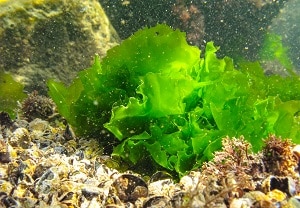Cristina Leon Vera | 08/08/2024
Is it feasible to grow seaweed in the desert? The objective of this initiative, which is recognized by the UN and the International Maritime Organization, is to produce biofuel to offer a promising alternative to extractive mining and fossil fuels.
The perfect place to deploy the seaweed growing operation proposed by the project Seah4 is in Africa, according to co-founder Johannes Bochdalofsky. This initiative opens the door to a sustainable, innovative option for energy independence in the region. “This initiative arose when we saw a port strangled by an algae bloom, while South Africa was struggling to import enough oil,” the expert explains.
The initial purpose of this project has three objectives:
- Enable the region to join the global fight against climate change, keeping in mind its severe economic limitations.
- Allow Africa to become less dependent on global supply chains and reduce the negative impact of commodity trade in foreign currency.
- Generate local economic opportunities in areas that don’t have the sufficient infrastructure to attract other industries.
A common seaweed as a starting point

Underwater landscape, Black Sea. Green algae on the seabed (Ulva, Enteromorpha), Bulgaria
To carry out this project and avoid geographical limitations, a common genus of seaweed was chosen: Ulva Lactuca, also known as sea lettuce, a native species to most of the coastlines on the planet. This allows the project to grow a non-invasive or non-exotic species that won’t negatively impact the natural environment through its growth or bioconversion.
“This seaweed is grown in what are called raceway or paddlewheel ponds, which can be set up along the desert coast without encroaching on important habitats or farmlands,” Bochdalofsky explains.
The seaweed is converted to biogas through the anaerobic digestion of microorganisms, which is then divided into biogenic methane (CH4) and CO2. “The former is ready to be used as a fuel, and the latter is synthesized with green hydrogen into e-methanol,” adds the founder of Seah4, whose low-carbon compound can be used as fuel (especially maritime fuel or in industrial processes).
Major applications and challenges
The product derived from this seaweed has multiple uses, which are highly relevant to the economic development of any region:
- Compressed Natural Gas (CNG), which can be used by tugboats and other ships that operate nearshore.
- Liquefied Biomethane (LBM), a viable replacement for Liquefied Natural Gas (LNG).
- E-Methanol, a fuel in very high demand due to its compatibility with existing infrastructure and its excellent potential for decarbonization.
Although experts have high expectations for success, there are also considerable challenges linked to the early stages of development for this project, as well as the investment that will be required to consolidate it within the sector. “It’s a solution based on a newly created technology, and our greatest handicap, by far, is the financing we need at this stage. Until now, the initiative has been funded by the research team itself, which certainly slows down the process,” says Bochdalofsky, who acknowledges that recent support has allowed them to begin construction of a large facility to run field tests and launch a pilot project.
Advantages compared to other energy sources
The use of natural, non-invasive sources to generate fuel is becoming more common worldwide, and seaweed can play an important role in this market, which has enormous economic potential and a positive impact on public well-being. In addition to creating jobs and attracting talent to areas lacking sustainable industries to grow on, this project could also be developed using existing infrastructure for obsolete fossil fuel businesses. “Our facilities can act as the jumping-off point in areas with very high unemployment rates, providing energy and reserve raw materials for local SMEs. Additionally, their structure will require third-party service providers for day-to-day operations,” Seah4 notes.
The environmental and social benefits of using seaweed as fuel are also very promising, given the demanding energy transition the world is undergoing:
- The grow facilities neutralize almost 90 tons of CO2 per hectare by replacing fossil fuels.
- They generate large-scale employment opportunities in marginalized fishing communities, where poaching marine resources has become the only source of income, which reduces the pressure on certain marine species.
- Seaweed consumes CO2 dissolved in the ocean, which helps locally reduce water acidification and positively impacts organisms such as coral, mussels and lobsters.
The contributor to this article is…

Johannes Bochdalofsky, an engineer who has dedicated the last four years to launching the start-up Seah4. Before that, he worked as a project manager in the energy, maritime, salvage and naval construction sectors.
Seah4 is a leading company in the search for an alternative to fossil fuels with zero net CO2 emissions, that’s consumer-ready and doesn’t require large investments in infrastructure and transportation.





